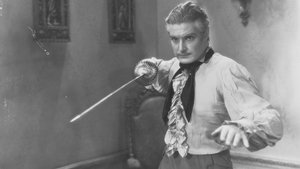Contact: info@alwanfilm.com
Video Sources 0 Views

Synopsis
The Count of Monte Cristo 1934 Colorized Review: A Timeless Tale of Revenge and Redemption

Introduction
Few stories have stood the test of time as resolutely as The Count of Monte Cristo, and the 1934 film adaptation of Alexandre Dumas’ classic novel remains a shining example of cinematic storytelling. Directed by Rowland V. Lee, this black-and-white film brings to life the thrilling adventure of Edmond Dantès, a man betrayed by his friends and driven by a quest for vengeance. Though it was produced in the early days of sound cinema, the film’s rich narrative, strong performances, and atmospheric direction have earned it a lasting place in film history. In this review, we’ll explore the 1934 version of The Count of Monte Cristo, delve into its production, the performances that made it memorable, and the impact it has had on cinema as an early attempt at large-scale epic storytelling.
Check The Full Colorized Movies List
Check Our Colorized Movies Trailer Channel
Understanding The Count of Monte Cristo 1934 Colorized: Director, Cast, and Genre
Director’s Vision
Rowland V. Lee was no stranger to historical epics, having directed films that brought the grandeur of past eras to life. His approach to The Count of Monte Cristo was both respectful of the source material and innovative for its time. Lee aimed to capture the complexity of Edmond Dantès’ transformation from a naive sailor to a master strategist seeking revenge. His vision for the film emphasized the inner turmoil of the characters while maintaining the story’s adventurous spirit. The moody atmosphere, dark shadows, and sharp contrasts in the cinematography underscored Dantès’ journey from despair to triumph, creating an emotionally resonant and visually compelling adaptation.
The Iconic Performance of Actors
Robert Donat, who takes on the lead role of Edmond Dantès, delivers one of the most iconic performances in classic cinema. Donat’s portrayal of Dantès is multi-dimensional—he moves seamlessly from the innocent, wrongfully imprisoned sailor to the calculating, sophisticated Count of Monte Cristo. His ability to convey Dantès’ pain, anger, and ultimately his search for justice is the emotional core of the film. Donat’s nuanced performance makes the audience sympathize with his character even as his plans for revenge unfold in ruthless fashion.
The supporting cast of The Count of Monte Cristo (1934) adds depth to the story as well. Elissa Landi plays Mercedes, Dantès’ beloved, with a tragic dignity, and Louis Calhern as the treacherous prosecutor De Villefort exudes arrogance and corruption. Sidney Blackmer and Raymond Walburn, as two of Dantès’ betrayers, give strong performances that emphasize the cowardice and greed at the heart of the conspiracy. Together, this ensemble creates a compelling depiction of a world filled with betrayal, power, and moral ambiguity.
Exploring the Genre
The Count of Monte Cristo (1934) is an adventure film that blends elements of drama, romance, and action. As a historical epic, it explores themes of injustice, revenge, and redemption within the context of early 19th-century France. The film also has the hallmarks of a classic swashbuckler, with daring escapes, duels, and moments of high tension. However, it stands apart from many films of the adventure genre at the time by focusing on the psychological depth of its characters, especially the transformation of its protagonist.
Exploring the World of The Count of Monte Cristo 1934 Colorized: Plot and Characters
Detailed Synopsis
The story of The Count of Monte Cristo follows Edmond Dantès (Robert Donat), a young sailor falsely accused of treason by his jealous friends and sentenced to life in the Château d’If, a notorious island prison. During his years in captivity, Dantès befriends a fellow prisoner, the Abbé Faria, who not only educates him but reveals the location of a hidden treasure on the Isle of Monte Cristo. After Faria’s death, Dantès escapes from the prison, retrieves the treasure, and transforms himself into the mysterious and wealthy Count of Monte Cristo.
Armed with his new identity and vast fortune, Dantès embarks on a calculated plan to exact revenge on those who wronged him, including his former best friend Fernand Mondego (Sidney Blackmer), the corrupt prosecutor De Villefort (Louis Calhern), and the duplicitous Danglars (Raymond Walburn). Along the way, Dantès encounters old loves, forms new alliances, and questions the morality of his vengeful quest. The film builds toward a thrilling climax as Dantès’ carefully laid plans unfold and he confronts the individuals responsible for his suffering.
Complex Protagonist and Memorable Supporting Characters
At the heart of The Count of Monte Cristo is Edmond Dantès, a complex protagonist whose transformation from an innocent sailor to a man consumed by vengeance is both compelling and tragic. Dantès’ journey is not just physical but psychological, as he wrestles with the consequences of his quest for revenge. Donat’s portrayal captures this complexity, making Dantès a sympathetic figure even as his actions become more ruthless.
Mercedes (Elissa Landi), Dantès’ fiancée, serves as a tragic figure in the story. Her love for Dantès and her suffering after his imprisonment add emotional weight to the film. Meanwhile, the villains—Fernand, De Villefort, and Danglars—are depicted as morally corrupt, but their motivations are explored in enough depth to prevent them from becoming mere caricatures. Each character plays a crucial role in Dantès’ revenge, and their ultimate fates are intricately tied to the choices they made at the story’s outset.
The Art of Film Colorization
Understanding the Process
Although The Count of Monte Cristo (1934) was released in black and white, the discussion of colorization brings an interesting dimension to the film’s legacy. In the decades that followed, film studios began experimenting with colorization, adding color to black-and-white films to make them more appealing to contemporary audiences. The process of colorization involves digitally adding hues to each frame, often using historical references and artistic interpretations to recreate the look of a scene.
Development Over Time
Film colorization has evolved significantly since the early days of hand-tinting and technicolor processes. The advent of digital technology has made colorization more precise and accessible, though it remains a controversial practice in the world of film preservation. Many purists argue that colorization alters the original artistic vision of a film, while others believe it can breathe new life into classic films by making them more appealing to modern audiences.
Early Colored Films: A Brief History
Emergence of Early Colored Techniques
The journey toward full-color cinema began in the early 20th century with processes like tinting, toning, and hand-painting. These techniques allowed filmmakers to add color to specific scenes or elements, creating a more dynamic visual experience. By the 1930s, Technicolor emerged as the dominant color process, used in films like The Wizard of Oz (1939) and Gone with the Wind (1939). Although The Count of Monte Cristo was shot in black and white, it came at a time when color film was becoming more feasible for large productions.
The Count of Monte Cristo 1934 and Its Early Colored Version
Colorization’s Impact on the Visual Narrative
Though The Count of Monte Cristo (1934) has not been widely colorized, discussions about adding color to such classics often center around whether doing so enhances or detracts from the original viewing experience. The stark black-and-white cinematography of the film is a crucial element of its mood and atmosphere. The shadows, contrasts, and chiaroscuro lighting techniques used in the film help convey Dantès’ descent into darkness and his gradual rise to power. Adding color to this film would alter its visual language and potentially weaken the emotional impact that its monochromatic palette delivers.
The Debate Over Film Colorization
Controversy Surrounding Colorization
The practice of colorizing black-and-white films has long been a subject of heated debate. Critics argue that colorization can distort the director’s original vision and change the mood of the film. For a story like The Count of Monte Cristo, where the visual aesthetic plays a significant role in conveying the themes of isolation, despair, and revenge, colorizing the film could risk diminishing its impact.
On the other hand, proponents of colorization point out that it can make classic films more accessible to modern audiences who may be less inclined to watch black-and-white films. In this way, colorization can act as a bridge between older films and new generations of viewers, ensuring that the stories remain relevant and appreciated.
Examining The Count of Monte Cristo 1934 as an Early Colored Film
Would Colorization Enhance or Detract?
If The Count of Monte Cristo (1934) were colorized, it’s possible that the rich settings, elaborate costumes, and grandiose locations would benefit from the added visual detail. The opulence of the Monte Cristo estate, the dark, foreboding prison cells, and the vibrant atmosphere of post-Napoleonic France could all be enhanced by color. However, the film’s thematic core—Dantès’ emotional and moral struggle—may not benefit from such a change. The stark contrasts of black and white reflect the binary oppositions in the film: innocence versus guilt, justice versus vengeance, and love versus betrayal. Removing this visual contrast could lessen the film’s psychological depth.
Influence and Legacy: The Count of Monte Cristo 1934 Colorized’s Impact on Cinema
The Adventure Genre’s Evolution
The Count of Monte Cristo (1934) influenced the adventure genre and set the standard for adaptations of classic literature in film. Its success demonstrated the appetite for swashbuckling tales of revenge, treasure, and romance, and inspired many later films. The idea of the wronged hero seeking justice became a popular trope in adventure cinema, echoed in films like Zorro, Robin Hood, and even contemporary blockbusters like The Dark Knight Rises (2012).
Director’s Cinematic Legacy: Beyond The Count of Monte Cristo 1934 Colorized
Rowland V. Lee’s Influence
Rowland V. Lee’s career spanned multiple genres, but his work on The Count of Monte Cristo solidified his reputation as a director capable of handling large-scale, character-driven narratives. He would go on to direct other historical epics and adventure films, influencing filmmakers who sought to blend emotional depth with action-oriented storytelling. His work laid the groundwork for future directors of historical dramas and adventure films.
Themes Explored in The Count of Monte Cristo 1934 Colorized
Darkness, Morality, and Revenge
The central theme of The Count of Monte Cristo is the moral ambiguity of revenge. Dantès’ quest for justice is understandable, but the lengths to which he goes—and the collateral damage caused by his actions—raise questions about the cost of vengeance. The film also explores the corrupting nature of power, as Dantès must navigate the moral complexities of using his newfound wealth and influence to right the wrongs of the past.
Reception and Controversy Surrounding The Count of Monte Cristo 1934 Colorized
Critical Reception
Upon its release, The Count of Monte Cristo (1934) received positive reviews for its faithful adaptation of Dumas’ novel, Robert Donat’s standout performance, and its engaging, suspenseful storyline. Critics praised the film’s ability to capture the epic scope of the novel while focusing on the psychological transformation of its central character. However, the film’s slow pacing in some sections and the omission of certain subplots from the novel received minor criticism.
Where to Watch The Count of Monte Cristo 1934 Colorized Online
For those looking to experience The Count of Monte Cristo (1934), the film is available for streaming on several platforms, including Amazon Prime Video and Criterion Channel. Physical copies on DVD and Blu-ray can also be found through online retailers.
FAQs About The Count of Monte Cristo 1934 Colorized
Q: How faithful is the 1934 adaptation to Alexandre Dumas’ novel?
A: The 1934 adaptation remains relatively faithful to the novel, though it condenses some subplots for brevity and focuses more on the revenge aspect of the story.
Q: Why was Robert Donat cast as Edmond Dantès?
A: Robert Donat was cast due to his ability to portray both the innocence of young Dantès and the calculated, vengeful Count, demonstrating the range required for such a complex character.
Conclusion
The Count of Monte Cristo (1934) stands as a timeless tale of vengeance, redemption, and the moral questions surrounding justice. Rowland V. Lee’s direction and Robert Donat’s unforgettable performance elevate the film, making it a classic of early cinema. Whether viewed in its original black-and-white format or hypothetically colorized, the film’s powerful narrative continues to resonate with audiences today, cementing its legacy as one of the most enduring adaptations of Alexandre Dumas’ masterpiece.













